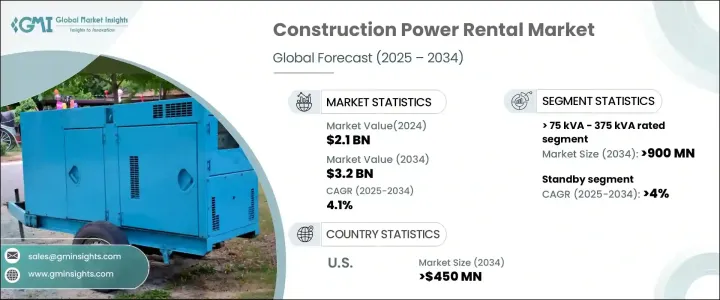
세계의 건설 전력 렌탈 시장은 2024년에 21억 달러로 평가되었으며, 2025년부터 2034년에 걸쳐 CAGR 4.1%로 성장할 것으로 예상됩니다.
이러한 확장은 기술 발전, 지속 가능한 에너지 솔루션에 대한 수요 증가, 인프라 파이낸싱 프로젝트의 증가와 같은 주요 요인에 기인합니다. 건설 프로젝트가 점점 더 복잡해지고 환경을 고려하게 되면서 효율적이고 친환경적인 동력원의 필요성이 우선순위가 되고 있습니다. 태양광, 풍력 등 재생 에너지원이 임시 전력 시스템에 지속적으로 통합되면서 시장에 활력을 불어넣고 있습니다. 더 나은 에너지 관리와 원격 모니터링을 가능하게 하는 디지털 기술도 전력 렌탈 서비스의 효율성과 신뢰성을 향상시키는 데 중요한 역할을 하고 있습니다. 또한, 글로벌 지속 가능성 목표에 따라 디젤과 같은 기존 연료원과 청정 에너지 옵션을 결합한 하이브리드 전력 시스템에 대한 수요가 증가하고 있습니다.

건설 전력 렌탈 시장에서 가장 유망한 부문 중 하나는 정격 75-375kVA의 발전기 수요입니다. 이 부문은 2034년까지 9억 달러의 수익을 창출할 것으로 예상되며, 이는 중간 규모의 건설 현장에 적합한 중급 발전기에 대한 수요가 증가하고 있음을 반영합니다. 이러한 발전기는 건설 중장비와 기계에 일관되고 안정적인 전력을 공급하여 중단 없이 지속적인 운영을 보장하도록 설계되었습니다. 다운타임을 줄이고 생산성을 높이려는 건설 회사가 늘어나면서 이러한 다목적 발전기는 프로젝트 진행에 필수적인 요소가 되고 있습니다. 동시에 건설 회사들이 환경 발자국을 줄여야 한다는 압박에 직면하면서 디젤과 재생 에너지를 모두 사용하는 하이브리드 발전기에 대한 수요도 빠르게 증가하고 있습니다.
| 시장 범위 | |
|---|---|
| 시작 연도 | 2024년 |
| 예측 연도 | 2025-2034년 |
| 시작 금액 | 21억 달러 |
| 예측 금액 | 32억 달러 |
| CAGR | 4.1% |
건설 대기 전력 대여 시장도 눈에 띄는 성장세를 보이고 있으며 2034년까지 4%의 연평균 성장률을 달성할 것으로 예상됩니다. 특히 외딴 지역과 개발도상국에서 백업 전력의 필요성이 심화됨에 따라 많은 건설 프로젝트에서 비용이 많이 드는 지연을 피하기 위해 안정적인 전력 시스템에 의존하고 있습니다. 허리케인이나 홍수와 같은 기상이변의 빈도가 증가함에 따라 안정적인 전력 백업 시스템의 중요성이 더욱 강조되고 있습니다. 또한 건설 단계에서 임시 전력 솔루션이 필요한 대규모 인프라 프로젝트와 스마트 시티 개발은 대기 전력 수요 증가에 기여하고 있습니다.
미국의 건설 전력 렌탈 시장은 기술 혁신, 엄격한 환경 규제, 임시 전력 솔루션에 대한 수요 증가로 인해 2034년까지 4억 5,000만 달러에 달할 것으로 예상됩니다. 교통, 에너지, 유틸리티와 같은 부문에서 건설업의 급속한 성장이 이러한 시장 확대를 계속 뒷받침할 것으로 예상됩니다. 또한 엄격한 배기가스 규제로 인해 더 깨끗하고 지속 가능한 전원의 사용이 장려되고 있습니다. 또한 자연재해의 빈도가 증가함에 따라 재해 복구 노력에 필수적인 모듈식 확장형 전력 솔루션에 대한 수요가 증가하고 있습니다. 건설 프로젝트가 진화함에 따라 다양하고 증가하는 수요를 충족하기 위한 유연하고 효율적인 전력 렌탈 서비스에 대한 필요성도 커지고 있습니다.
The Global Construction Power Rental Market, valued at USD 2.1 billion in 2024, is set to experience robust growth at a CAGR of 4.1% from 2025 to 2034. This expansion is largely attributed to key factors such as technological advancements, the growing demand for sustainable energy solutions, and an increase in infrastructure financing projects. As construction projects become more complex and environmentally conscious, the need for efficient, eco-friendly power sources is becoming a priority. The ongoing integration of renewable energy sources, such as solar and wind power, into temporary power systems is fueling the market. Digital technologies, which allow for better energy management and remote monitoring, are also playing a crucial role in improving the efficiency and reliability of power rental services. Moreover, there is a rising demand for hybrid power systems that combine traditional fuel sources like diesel with cleaner energy options, aligning with global sustainability goals.

One of the most promising segments within the construction power rental market is the demand for generators rated between 75 kVA and 375 kVA. This segment is projected to generate USD 900 million by 2034, reflecting the growing need for mid-range generators suitable for medium-scale construction sites. These generators are designed to provide a consistent and reliable power supply for heavy construction equipment and machinery, ensuring continuous operations without interruptions. With more construction companies seeking to reduce downtime and boost productivity, these versatile generators are becoming essential for keeping projects on track. At the same time, as construction companies face increasing pressure to reduce their environmental footprint, the demand for hybrid generators, which use both diesel and renewable energy, is rapidly increasing.
| Market Scope | |
|---|---|
| Start Year | 2024 |
| Forecast Year | 2025-2034 |
| Start Value | $2.1 Billion |
| Forecast Value | $3.2 Billion |
| CAGR | 4.1% |
The standby construction power rental market is also witnessing notable growth and is projected to achieve a CAGR of 4% through 2034. As the need for backup power intensifies, especially in remote and developing regions, more construction projects are relying on reliable power systems to avoid costly delays. The growing frequency of extreme weather events, such as hurricanes and floods, further underscores the importance of dependable power backup systems. Additionally, large-scale infrastructure projects and smart city developments, which often require temporary power solutions during the construction phase, are contributing to the rising demand for standby power.
In the U.S., the construction power rental market is expected to generate USD 450 million by 2034, driven by technological innovations, stringent environmental regulations, and a rising demand for temporary power solutions. The rapid growth in construction across sectors like transportation, energy, and utilities is expected to continue supporting this expansion. Strict emissions regulations are also encouraging the use of cleaner, more sustainable power sources. Furthermore, the increasing frequency of natural disasters is leading to a greater demand for modular, scalable power solutions, which are essential for disaster recovery efforts. As construction projects evolve, so too does the need for flexible, efficient power rental services to meet diverse and growing demands.